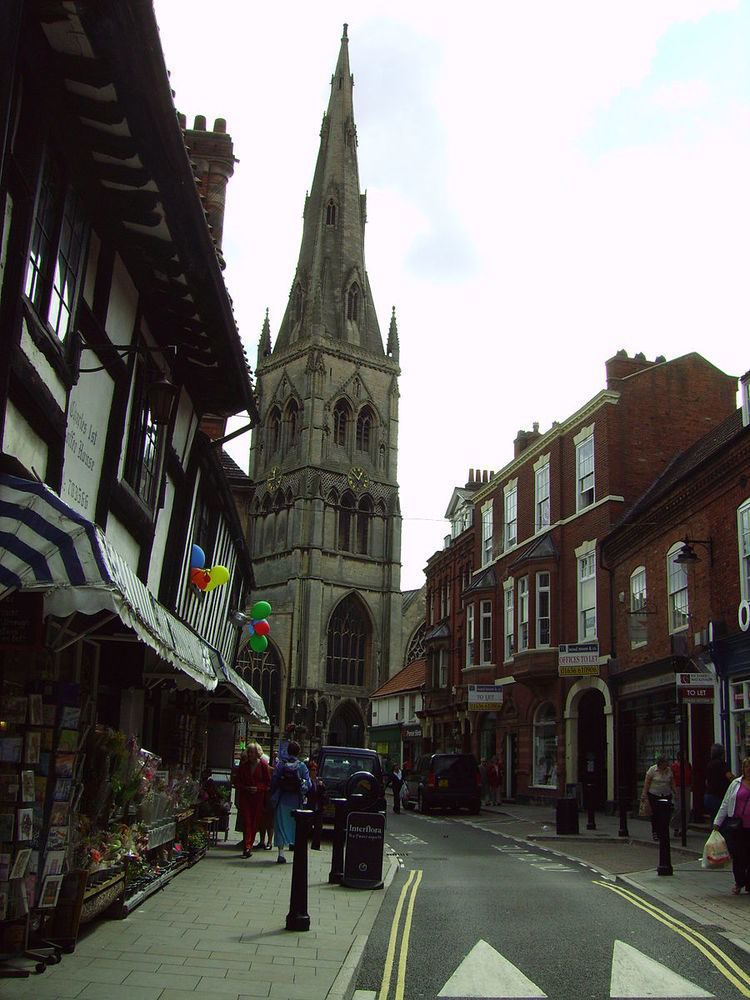Denomination Church of England Deanery Newark and Southwell Province York Phone +44 1636 706473 | Dedication St Mary Magdalene Archdeaconry Newark Parish Newark-on-Trent | |
 | ||
Website www.newarkanglican.org.uk Address Church Walk, Newark NG24 1JS, UK Diocese Diocese of Southwell and Nottingham Similar Newark Castle - Nottinghamshire, National Civil War Centre, St Mary's Church - Nottingham, Christ Church - Newark, Southwell Minster | ||
The Church of St Mary Magadalene, Newark-on-Trent is a parish church in the Church of England in Newark-on-Trent in Nottinghamshire.
Contents
- History
- Exterior
- The interior
- The Magnus Bequest
- Organ
- The Choir
- Masters of the Song School
- Concerts
- Assistant organists
- References
The church is Grade I listed by the Department for Culture, Media and Sport as a building of outstanding architectural or historic interest.
History
The present church is the third on this site. The Saxon church that stood on the site was in the manor of the Earl of Mercia and his wife Lady Godiva, but nothing of that structure now remains. Newark had been granted by the Earl to the monks of Stow.
Exterior
It is notable for the tower and the octagonal spire (236 feet (72 m) high), the highest in Nottinghamshire and reputed to be the fifth tallest in the UK. The central piers remain from the previous church, dating from the 11th or 12th century. The upper parts of the tower and spire were completed about 1350; the nave dates from between 1384 and 1393, and the chancel from 1489.
The sanctuary is bounded on the south and north by two chantry chapels, the former of which has on one of its panels a remarkable painting from the Dance of Death. There are a few old monuments, and an exceedingly fine brass of the 14th century. There is a hole in the spire which was supposedly made by a musket ball during the Civil War, although there is doubt locally as to the truth of the story. This hole is visible from some parts of the town centre.
The interior
On the north wall hangs the oil painting The Raising of Lazarus by William Hilton RA. It was previously used as an altarpiece for the High Altar.
It was heavily restored in the mid nineteenth century by Sir George Gilbert Scott. The reredos was added by Sir Ninian Comper.
The reredos, given in 1937 in memory of William Bradley and his wife Elizabeth, was designed by Sir Ninian Comper.
The Magnus Bequest
The church is supported by the Magnus Bequest, a charitable foundation created in the early 1530s by Thomas Magnus, who gave farms and lands in south Yorkshire, Lincolnshire and Nottinghamshire for a fourfold purpose:
Organ
At the beginning of the 19th century a new organ, by George Pike England, with three manuals, was provided by the trustees of the Magnus, Brown's and Phyllypott's charities at a cost of £1,300. It was opened on 11 November 1804 by Thomas Spofforth.
It was placed on the west gallery from where the choir sang services. In 1814 the organ was re-located on the chancel screen and the choir returned to the chancel. In the 1850s the organ was rebuilt by Forster and Andrews of Hull, provided with a new case and again re-located, this time to its present position in the south choir aisle.
In 1866 the organ was rebuilt and enlarged by Henry Willis. Willis virtually doubled the size of the instrument and its case, creating a large Romantic four-manual organ. The organ was again rebuilt by William Hill & Sons in 1910 at the expense of Mrs Becher Tidd Pratt and family, and subsequently by Hill, Norman and Beard in 1924, 1938, 1964 and 1978 when it was rebuilt and more voices added.
It is now electrically operated by the Ellen Dynamic Transmission system which allows much greater mobility of the organ console, providing more direct contact with the congregation and the choir; it is the first four-manual instrument in the country to be so equipped, enabling a live performance to be electronically recorded and replayed automatically.
The Choir
The Choral Foundation was set up by Thomas Magnus in 1532 and was said to be the only existing pre-reformation choir outside cathedrals and Oxbridge colleges. Girl choristers were admitted into the main choir from 2008.
In February 2012 choral services stopped following the dismissal of the Master of the Song School. The choir was refounded in 2015. It has an emphasis on the training of young people, supported by the Magnus Bequest.
Masters of the Song School
There have been appointments since at least 1532.
Concerts
The church hosts several concerts, including a "Music for Market" series at lunchtime on Saturdays.
